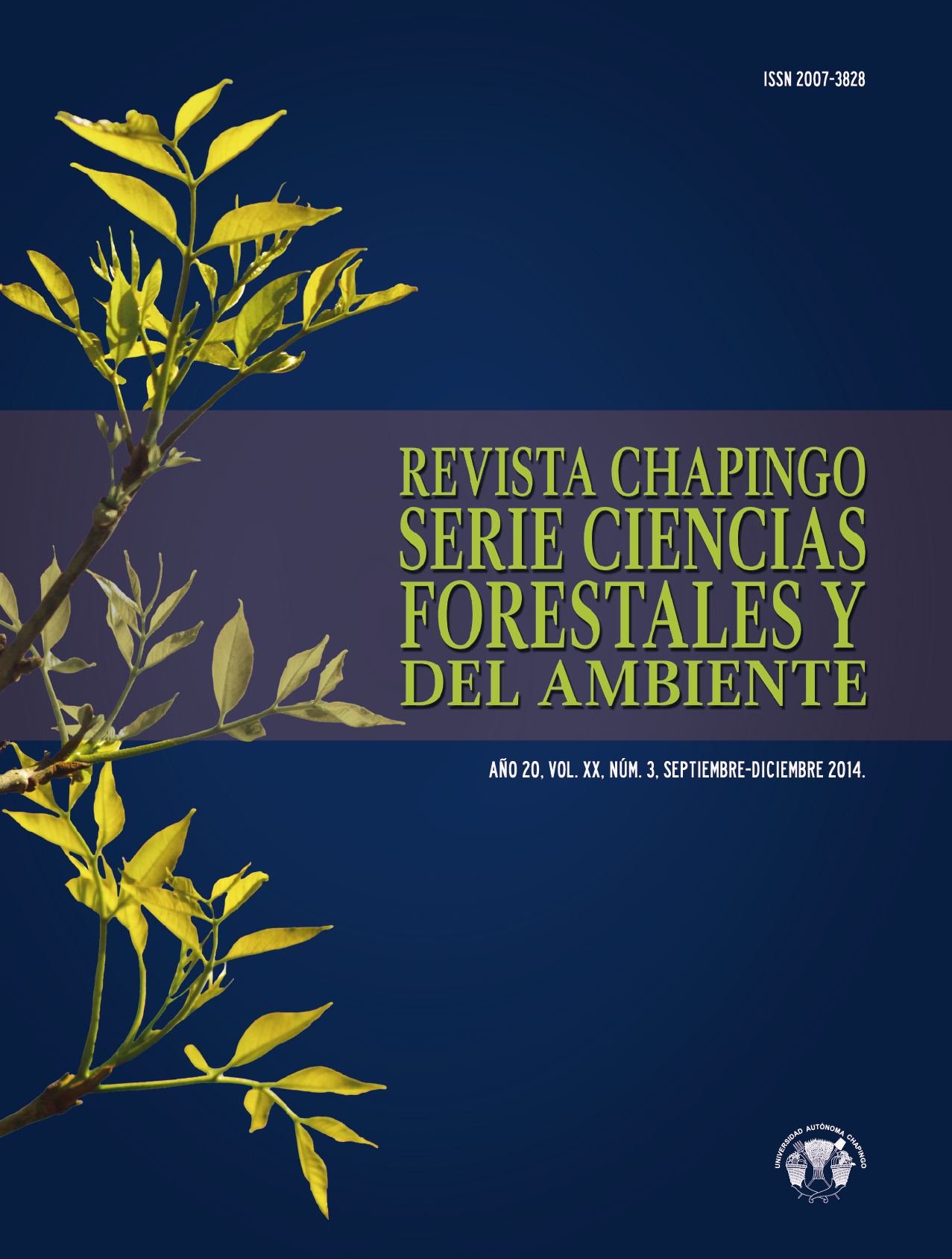Abstract
Pinus cembroides Zucc forests has usually been segregated from commercial logging given their woody disadvantages. However, this species plays an important role in the biodiversity of Mexico. The aim of the present study was to determine the concentration of carbon (C) in the main compartments of P. cembroides: root, bark, stem, branches, buds and leaves. The total C concentration expressed as percentage of biomass was determined with the Solids TOC Analyzer equipment. The results were analyzed in a completely randomized design and Tukey’s comparison of means. The analysis of variance evidenced that C concentration varied among components (P < 0.05); the bud had the highest value (57.1 %), while stem and branches recorded the lowest values (47.7 and 47.8 %, respectively). Our results contribute to improving C estimates for this species and provide important information to determine whether P. cembroides forests can be considered as a possible source with mitigation potential against climate change and thus use it in a C sequestration program.
References
Acosta-Mireles, M., Carrillo-Anzures, F., & Díaz-Lavariega, M. (2009). Determinación del carbono total en bosques mixtos de Pinus patula Schl. et Cham. TERRA Lationamericana, 27(2), 105–114. http://www.redalyc.org/articulo.oa?id=57311834003
Avendaño, D., Acosta, M., Carrillo, F., & Etchevers, J. (2009). Estimación de biomasa y carbono en un bosque de Abies religiosa. Fitotecnia Mexicana, 32(3), 233–238. http://www.redalyc.org/articulo.oa?id=61011739008
Bert, D., & Danjon, F. (2006). Carbon concentration variations in the roots, stem and crown of mature Pinus pinaster (Ait.). Forest Ecology Management, 222, 279–295. doi: https://doi.org/10.1016/j.foreco.2005.10.030
Casanova-Lugo, F., Petit-Aldana, J., & Solorio-Sánchez, J. (2011). Los sistemas agroforestales como alternativa a la captura de carbono en el trópico mexicano. Revista Chapingo Serie Ciencias Forestales y del Ambiente, 17(1), 133–143. doi: https://doi.org/10.5154/r.rchscfa.2010.08.047
Dhillon, R. S., & Von Wuehlisch, G. (2013). Mitigation of global warming through renewable biomass. Biomass Bioenergy, 48, 75–89. doi: https://doi.org/10.1016/j.biombioe.2012.11.005
Fonseca, W., Alice, F. E., & Rey-Benayas, J. M. (2012). Carbon accumulation in aboveground and belowground biomass and soil of different age native forest plantations in the humid tropical lowlands of Costa Rica. New Forest, 43, 197–211. doi: https://doi.org/10.1007/s11056-011-9273-9
Intergovernmental Panel on Climate Change (IPCC). (2006). Forest lands. Guidelines for national greenhouse gas inventories. Hayama, Japan: IPCC-Institute for Global Environmental Strategies (IGES).
Karlik, J. F., & Chojnacky, D. C. (2013). Biomass and carbon data from blue oaks in a California oak savanna. Biomass and Bioenergy, 62, 228–232. doi: https://doi.org/10.1016/j.biombioe.2013.11.018
Lal, R. (2004). Soil carbon sequestration impacts on global climate change and food security. Science, 304, 1623–1627. doi: https://doi.org/10.1126/science.1097396
Lamlom, S. H., & Savidge, R. A. (2003). A reassessment of carbon content in wood: Variation within and between 41 North American species. Biomass and Bioenergy, 25(4), 381–388. doi: https://doi.org/10.1016/S0961-9534(03)00033-3
Macchioni, F., Cioni, P. L., Flamini, G., Morelli, I., Maccioni, S., & Ansaldi, M. (2003). Chemical composition of essential oils from needles, branches and cones of Pinus pinea, P. halepensis, P. pinaster and P. nigra from central Italy. Flavour and Fragrance Journal, 18, 139–143. doi: https://doi.org/10.1002/ffj.1178
McClaran, M. P., Mcmurtry, C. R., & Archer, S. R. (2013). A tool for estimating impacts of woody encroachment in arid grasslands: Allometric equations for biomass, carbon and nitrogen content in Prosopis velutina. Journal of Arid Environments, 88, 39–42. doi: https://doi.org/10.1016/j.jaridenv.2012.08.015
Monreal, C. M., Etchevers, B. J., Acosta, M., Hidalgo, C., Padilla, J. R., López, M., …Velásquez, A. (2005). A method for measuring above- and below-ground C reservas in hillside landscapes. Canadian Journal of Soil Science, 85, 523–530. doi: https://doi.org/10.4141/S04-086
Navarro, M. M., Róger, R. Ch., Ortiz, E., & Vilchez, B. (2013). Successional variation in carbon content and wood specific gravity of four tropical tree species. Bosque, 34(1), 33–43. doi: https://doi.org/10.4067/S0717-92002013000100005
Niinemets, Ü., Ellsworth, D. S., Lukjanova, A., & Tobias, M. (2001). Site fertility and the morphological and photosynthetic acclimation of Pinus sylvestris needles to light. Tree Physiology, 21, 1231–1244. http://treephys.oxfordjournals.org/content/21/17/1231.full.pdf
Pacala, S., & Socolow, R. (2004). Stabilization wedges: Solving the climate problem for the next 50 years with current technologies. Science, 305, 968–72. doi: https://doi.org/10.1126/science.1100103
Pacheco, E. F. C., Aldrete, A., Gómez, G. A., Fierros, G. A. M., Cetina, A. V. M., & Vaquera, H. H. (2007). Almacenamiento de carbono en la biomasa aérea de una plantación joven de Pinus greggii Engelm. Revista Fitotecnia Mexicana, 30(3), 251–254. doi: https://doi.org/http://www.redalyc.org/articulo.oa?id=61003006
Pompa-García, M., Solís-Moreno, R., Rodríguez-Téllez, E., PinedoÁlvarez, A., Ávila-Flores, D. Y. Hernández-Díaz, J. C., & Velasco- Bautista, E. (2010). Viewshed analysis for improving the effectiveness of watch towers in the North of Mexico. The Open Forest Science Journal, 3, 17–22. doi: https://doi.org/10.2174/1874398601003010017
Rodríguez-Laguna, R., Jiménez-Pérez, J., Aguirre-Calderón, O., Treviño-Garza, E., & Razo-Zárate, R. (2009). Estimación de carbono almacenado en el bosque de pino-encino en la reserva de la biosfera El cielo, Tamaulipas, México. Ra Ximhai, 5(3), 317–327. http://www.journals.unam.mx/index.php/rxm/article/view/15164/14413
Statistical Analysis System (SAS). (2004). SAS user’s guide statistics. Release 9.1. Cary, NC, USA: SAS Institute Inc.
Thomas, S. C., & Martin, A. R. (2012). Carbon content of tree tissues: A synthesis. Forests, 3, 332–352. doi: https://doi.org/10.3390/f3020332
Treviño, G. E. J. (2001). Estratificación de la información en el procesamiento digital de imágenes de satélite aplicado a la cartografía de los bosques de Pinus cembroides. Investigaciones Geográficas, 44, 54–63. http://www.redalyc.org/articulo.oa?id=56904408
Valentin, L., Kluczek-Turpeinen, B., Willför, S., Hemming, J., Hatakka, A., Steffen, K., & Tuomela, M. (2009). Scots pine (Pinus sylvestris) bark composition and degradation by fungi: Potential substrate for bioremediation. Bioresources Technology, 101, 2203–2209. doi: https://doi.org/10.1016/j.biortech.2009.11.052
Yerena, Y. J. I., Jiménez, P. J., Aguirre C, O., & Treviño, G. E. J. (2011). Concentración de carbono en la biomasa aérea del matorral espinoso tamaulipeco. Revista Chapingo Serie Ciencias Forestales y del Ambiente, 17(2), 283–291. doi: https://doi.org/10.5154/r.rchscfa.2010.02.004
Zhang, Q., Wang, C., Wang, X., & Quan, X. (2009). Carbon concentration variability of 10 Chinese temperate tree species. Forest Ecology Management, 258, 722–727. doi: https://doi.org/10.1016/j.foreco.2009.05.009

This work is licensed under a Creative Commons Attribution-NonCommercial 4.0 International License.
Copyright (c) 2014 Revista Chapingo Serie Ciencias Forestales y del Ambiente



